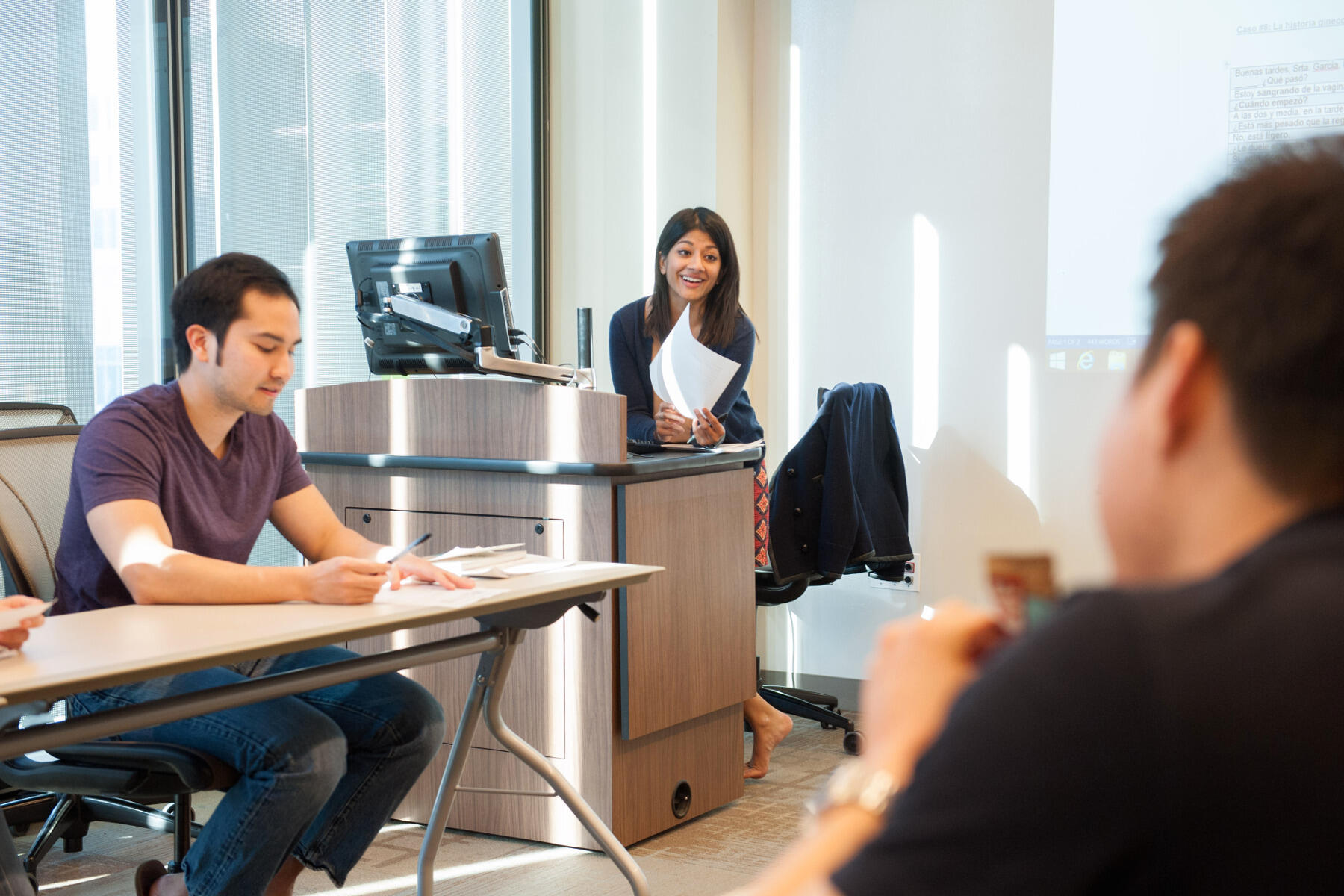
April 14, 2016
Building rapport: Medical Spanish class helps students connect with patients
Share this story
Unlike many children, the Virginia Commonwealth University School of Medicine Class of 2016’s Arhanti Sadanand looked forward to going to the doctor when she was young.
“I loved my pediatrician,” she said. “I felt like there was always someone there to help me feel better. My doctors were always my role models, and that stuck with me.”
My doctors were always my role models, and that stuck with me.
Once she entered VCU’s School of Medicine, Sadanand made it her mission to establish a similar rapport with her patients. One major tool she had at her disposal was her ability to speak Spanish.
“I’m lucky enough to have a background in Spanish,” said Sadanand, who minored in Spanish at New York University. “But many doctors don’t. Part of our responsibility is to communicate with all our patients as best we can so that we can build rapport.”
To help other medical students on the MCV Campus form a closer relationship with Spanish-speaking patients, Sadanand taught a Medical Spanish elective. The four-week class, offered twice this year, emphasized listening comprehension and oral fluency in realistic health care scenarios.
“This is critical for medical students,” she said. “The class has a focus on clinical dialogue they will use every day in the exam room.”
Sadanand taught common phrases and medical terms in a fun way. Participants often role played or competed in Spanish bingo, “Jeopardy!” and other games to bring some fun to the classroom.
“I wanted to make it more interactive,” Sadanand said. “Still, I don’t want anyone overestimating their abilities when they leave the class. They won’t be fluent, but it’s a great start.”
The class was Sadanand’s community-based capstone project, a requirement of the school’s International/Inner City/Rural Preceptorship Program. I2CRP is a four-year program that fosters the knowledge, skills and values needed by doctors to provide quality and compassionate care in medically underserved communities.
“This class helps bring our students much closer to making that all-important connection with patients,” said Mark Ryan, M.D., medical director of I2CRP.
Each session addresses specific topics: physicals, abdominal pain, respiratory infections, diabetes, hypertension, pregnancy, musculoskeletal complaints and pediatrics. At the end of the four weeks, Sadanand assessed Spanish proficiency with the help of a fluent Spanish speaker acting as the patient in a mock medical encounter.
Sadanand also compared improvement of and confidence in Spanish proficiency by using standardized pre-tests, post-tests and student surveys. She will present the results to the school’s curriculum council with hopes the class will be added to the School of Medicine’s catalogue.
“The vision and the drive she has brought to this project has been extraordinary,” said Mary Lee Magee, who serves as educational director of I2CRP. “There are limited resources available for our medical students in this area, and the need is so great.”
The class, however, does not replace a medical student’s obligation to use certified Spanish interpreters. Health care providers can call on live interpreters to visit patients and translate for them or use technology-assisted interpretation that are phone or web based.

But “there’s nothing like the personal touch,” Sadanand said. “When I put myself in the patients’ shoes, it must be terrifying. Imagine not being able to communicate with your doctor.”
Sadanand’s class builds upon the work of two previous I2CRP students, Irving Phillips and Patrick Lam, who each graduated in 2015. Their research showed the Teaching Proficiency through Reading and Storytelling method is an effective alternative to Rosetta Stone, which is more general. Sadanand’s fellow I2CRP student Deborah Me sees so much value in the approach that she volunteered to help with teaching duties when Sadanand was busy with her fourth-year rotation in pediatric hematology-oncology.
Shanti Nambiar was one of about 20 students enrolled in the class this year. “This has been extremely helpful,” she said. “It’s giving me the tools to get through a clinic visit.”
During her third year, when Sadanand completed her clinical rotations, she met at least one Spanish-speaking patient every day, she said. She is confident that number will only rise. According to the U.S. Census and other government sources, the United States is home to more than 41 million native Spanish speakers.
“What’s so important is building that trust with your patients,” said Sadanand, who is pursuing a pediatrics residency. “When you establish that link, when you bring your patients that comfort, everyone wins.”
Subscribe for free to the weekly VCU News email newsletter at http://newsletter.news.vcu.edu/ and receive a selection of stories, videos, photos, news clips and event listings in your inbox every Thursday.
Subscribe to VCU News
Subscribe to VCU News at newsletter.vcu.edu and receive a selection of stories, videos, photos, news clips and event listings in your inbox.







